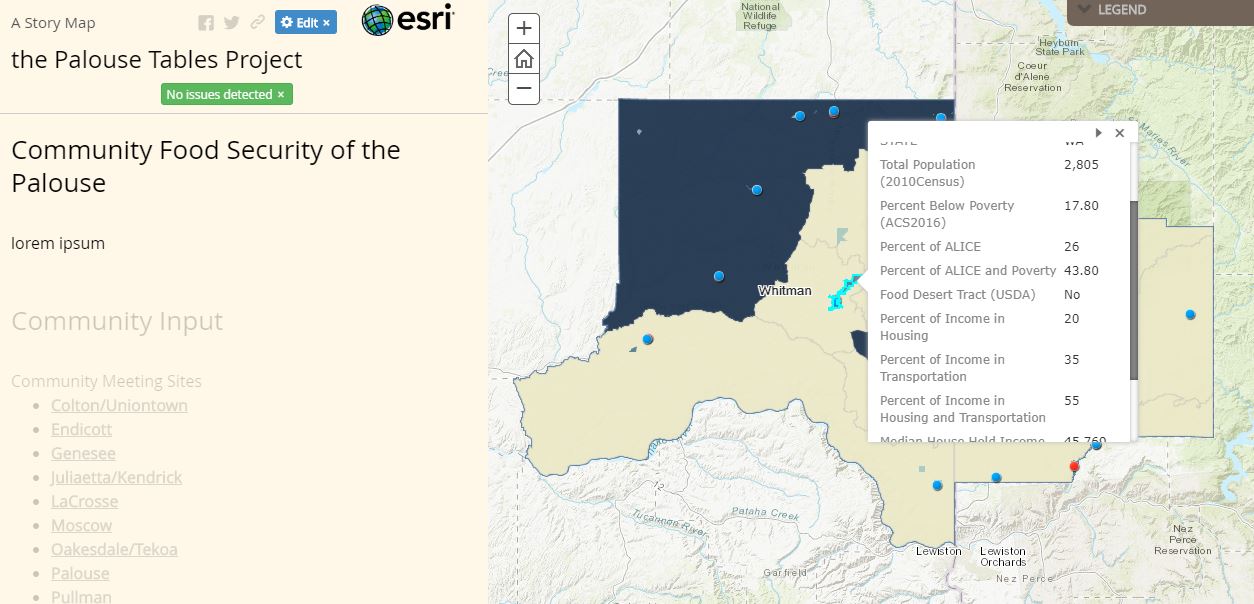
The Palouse Tables Project Uses ArcGIS Story Mapping the Communicate Finding
15 Nov 2018, by Admin in Harvest Blog, Harvest VISTA, Washington state, Community Action CenterHarvest Against Hunger AmeriCorps VISTA, Michelle Blankas, serves at the Community Action Center in Pullman, WA. The Community Action Center is a non-profit organization geared toward providing services to the community that include affordable housing assistance, weatherization and energy assistance, and community food such as the food bank, nutrition education, gardening, and Basic Food. The Community Action Center is a member of the Whitman County Food Coalition, of which, several partners make up the volunteer force for the Palouse Tables Project. The volunteer partners include Backyard Harvest, Council on Aging, Washington State University Center for Civic Engagement, and Harvest Against Hunger AmeriCorps VISTA.
The Palouse Tables Project is approaching the “Dissemination of Information Phase” of the project. A draft of the assessment and planning project has been completed and is undergoing formatting and editing. However, most people either do not have the time or patience to read a whole assessment and planning report. To make the project findings and results more communicable, the HAH VISTA has used ArcGIS Story Mapping to share those results. The story mapping interface has the advantage of being interactive, short, concise, incorporating major highlights of the report without getting too much into detail, and it illustrates information spatially or geographically which usually resonates with the public.
In order to use GIS software, the VISTA had to coordinate and leverage partnerships for the Palouse Tables Project. At the current HAH site, Community Action Center, GIS software is unavailable and because it usually takes some basic skill level to work GIS, applying for the program seemed unsustainable. However, the University of Idaho Extension, which supports a partnering agency, the Palouse-Clearwater Food Coalition (PCFC), was willing to host the Palouse Tables Project Story Map on their domain. This domain also hosts other community food projects for the PCFC so it was a more fitting place for the project to live. Additionally, it bolsters the relationship between the Community Action Center, PCFC, and the University of Idaho Extension. It also is far more sustainable in terms of the life of the project. Where there are some experienced GIS users on the UI Extension side that can work on the project after the HAH VISTA leaves, the Community Action Center does not have that capacity. This partnership and shared programing took a couple months to develop and really took affect after an initial workshop with the University of Idaho system
The first year HAH VISTA is currently working on a small group that is willing to work on the project after she leaves. A couple of Washington State University students have shown interest in the PTP Story Mapping Project and have decided to volunteer some of their time to learn the program and work on it.
For the sake of sustainability, the HAH VISTA is also working on hosting an ArcGIS workshop for employees at the Community Action Center so that they can take on the PTP Story Mapping Project, edit as they see fit, and use it to communicate to the public more easily. Should the Community Action Center ever decide to adopt ArcGIS, then they will have some basic skills to work the program.


